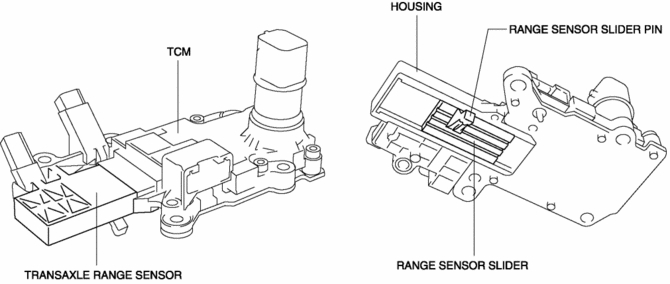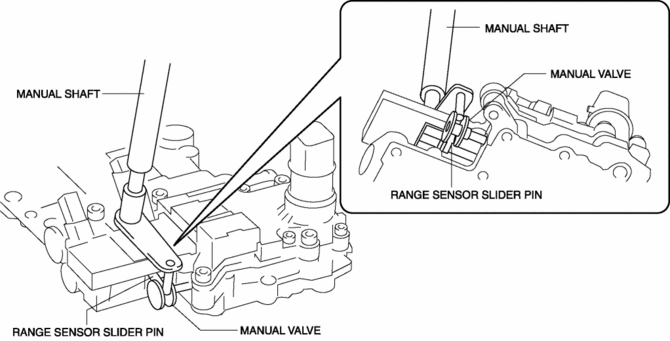Mazda CX-5 Service & Repair Manual: Transaxle Range Sensor [Fw6 A EL, Fw6 Ax EL]
Purpose/Function
-
The transaxle range sensor detects the position of the manual valve and selector lever.
-
The transaxle range sensor signal is used for automatic shift control, manual shift control, TCC control, line pressure control, direct electric shift control, learning control, engine-transaxle integration control, and the on-board diagnostic system.
Construction
-
The transaxle range sensor consists of a housing and slider which are installed to the control valve body as a part of the TCM.
-
The slider is assembled to the housing and the pin which projects from the slider and is connected to the manual valve.

Operation
-
When the selector lever is operated, the manual valve strokes via the manual shaft while the slider strokes via the slider pin.
-
The transaxle range sensor detects the signal corresponding to the manual valve position according to the slider stroke. This signal is calculated in the TCM and detected as a range position.

 Transaxle Fluid Temperature (Tft) Sensor [Fw6 A EL, Fw6 Ax EL]
Transaxle Fluid Temperature (Tft) Sensor [Fw6 A EL, Fw6 Ax EL]
Purpose/Function
The transaxle fluid temperature (TFT) sensor detects the ATF temperature
in the oil pan.
The transaxle fluid temperature (TFT) sensor signal is used for automatic
...
 Automatic
Automatic
...
Other materials:
Heated Oxygen Sensor (HO2 S) Heater Control [Skyactiv G 2.0]
Outline
Based on the control of the HO2S heater, a stabilized oxygen concentration
is detected even at low exhaust temperatures, and feedback control of fuel injection
even at cold engine start is made possible for improved cold temperature exhaust
emission performance.
Both ...
Mass Air Flow (MAF) Sensor Inspection
Visual Inspection
1. Remove the MAF sensor/IAT sensor No.1..
2. Visually inspect the MAF sensor for the following:
Damage, cracks, soiling
Rusted sensor terminal
Bent sensor terminal
If there is any malfunction, repair or replace the MAF sensor/IAT sensor
...
Starting System [Skyactiv G 2.0]
Outline
A coaxial reduction type starter has been adopted.
Structural View
Structure
Consists of the following parts:
Starter
(See STARTER [SKYACTIV-G 2.0].)
Starter relay
(See STARTER REL ...
